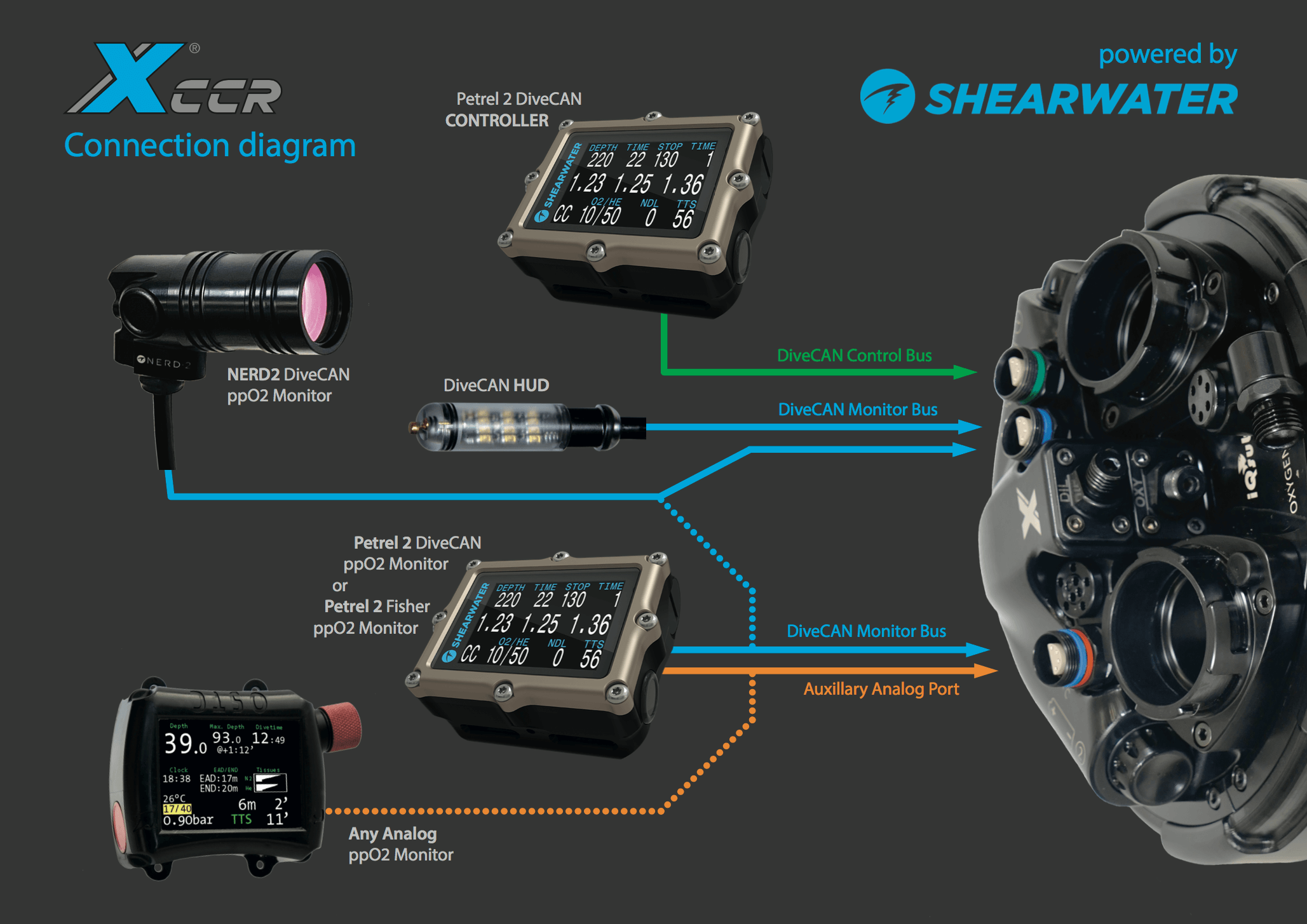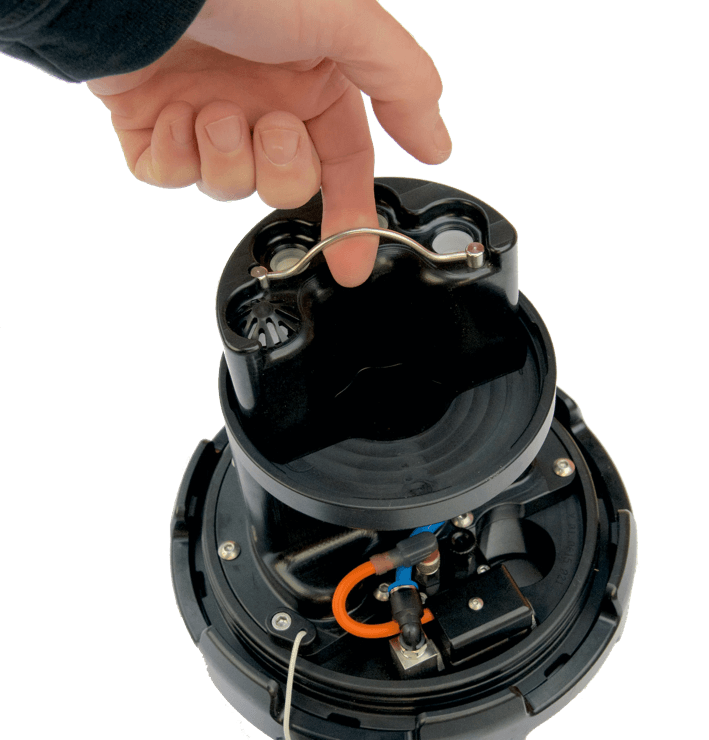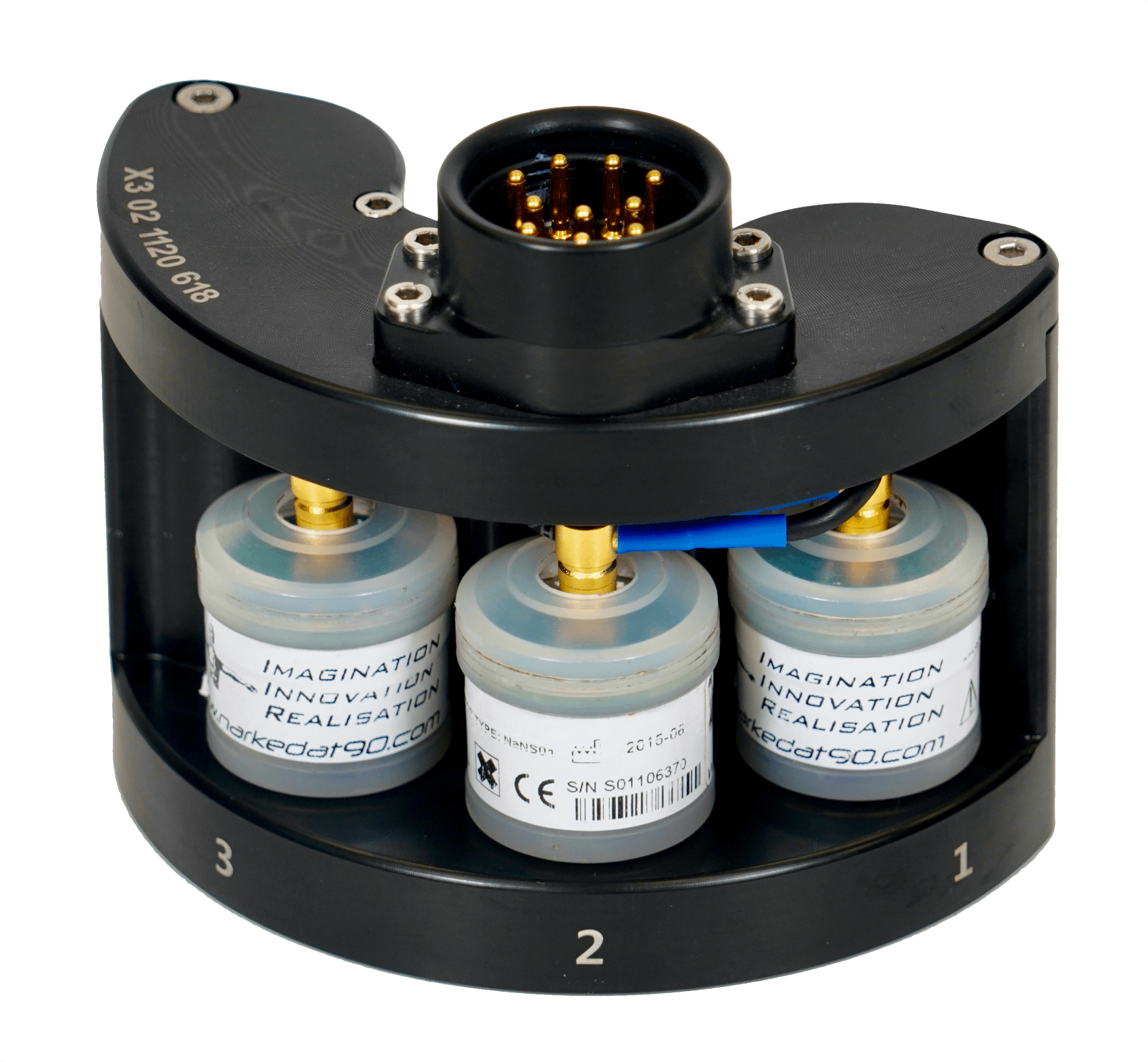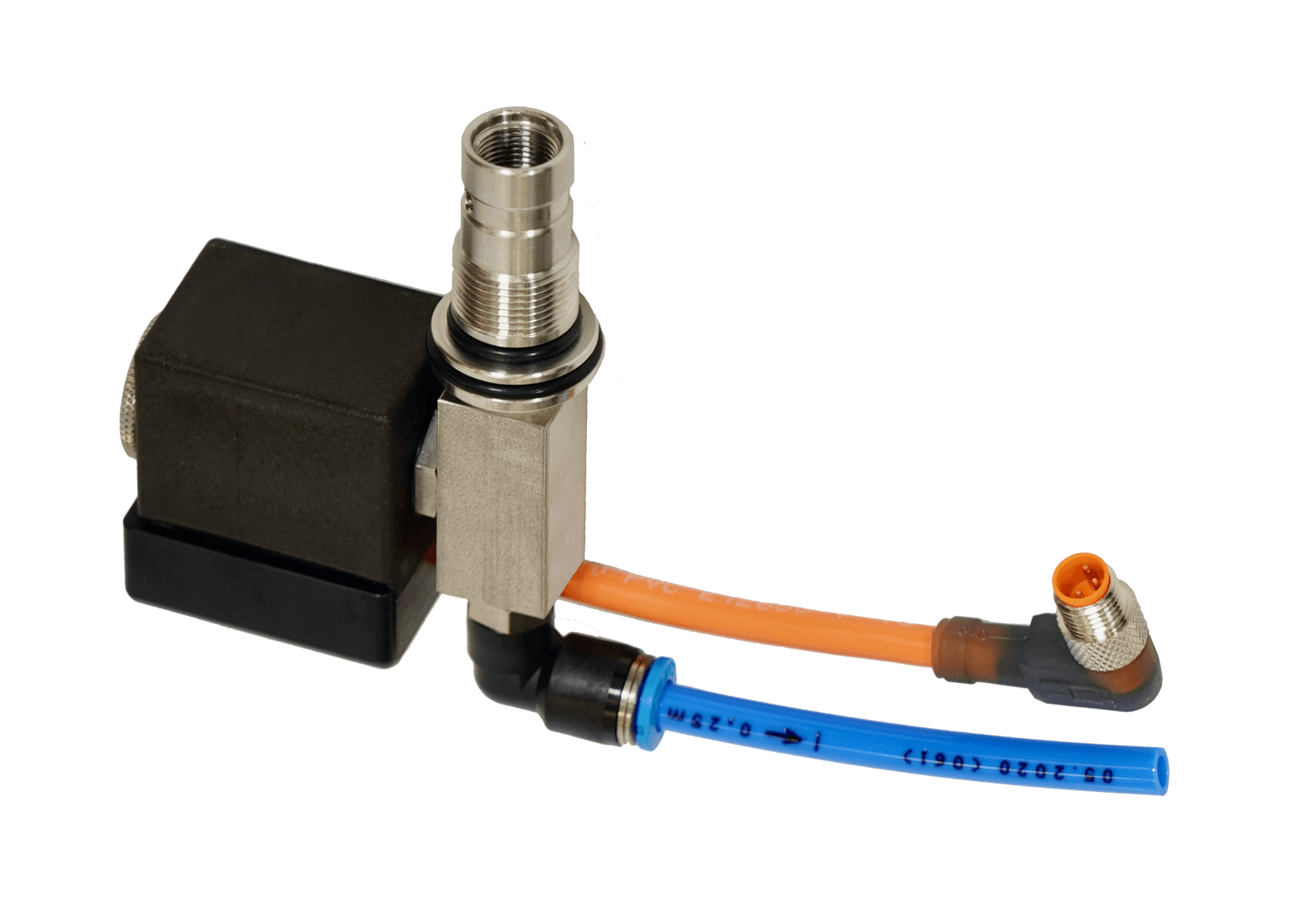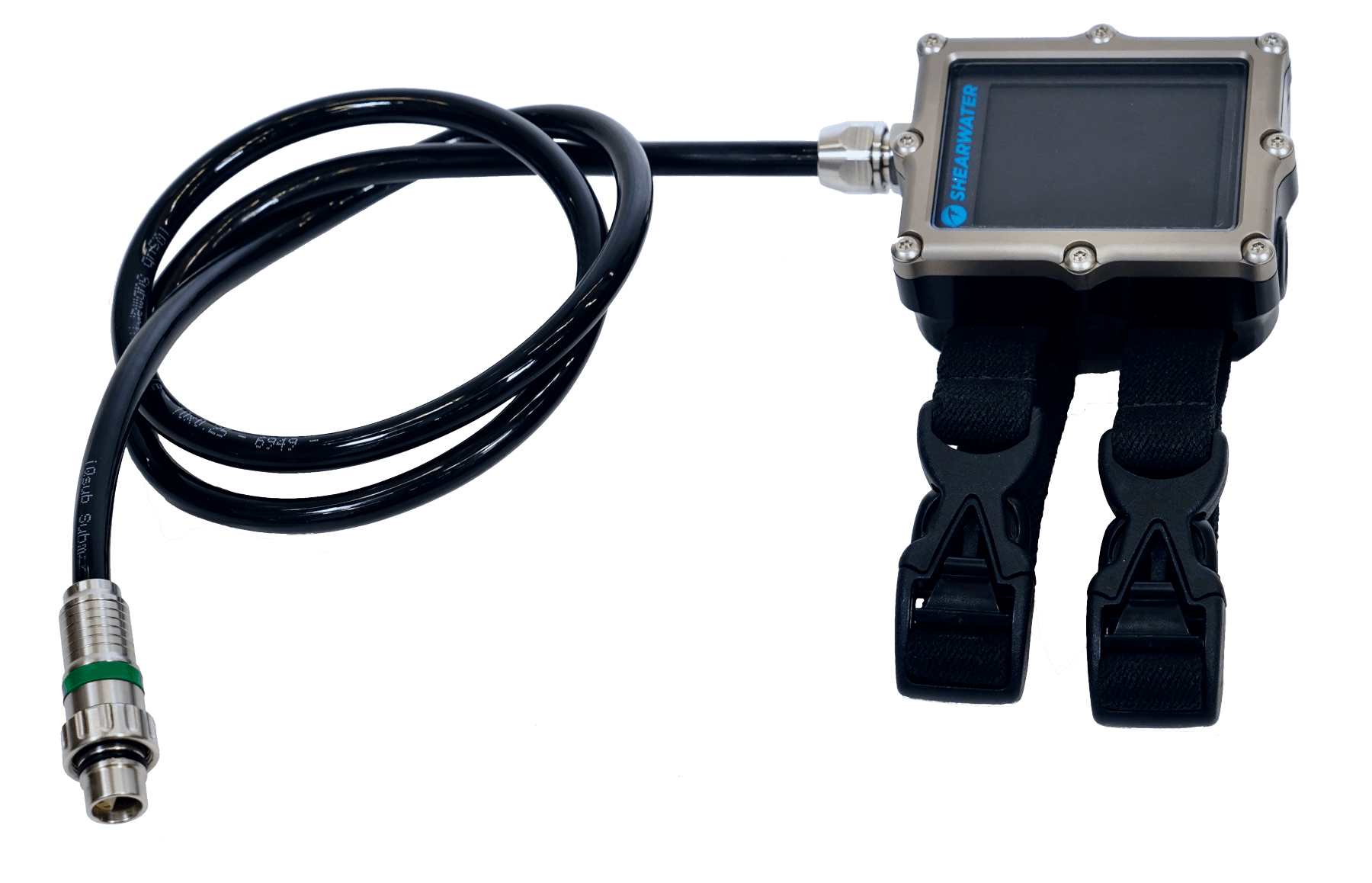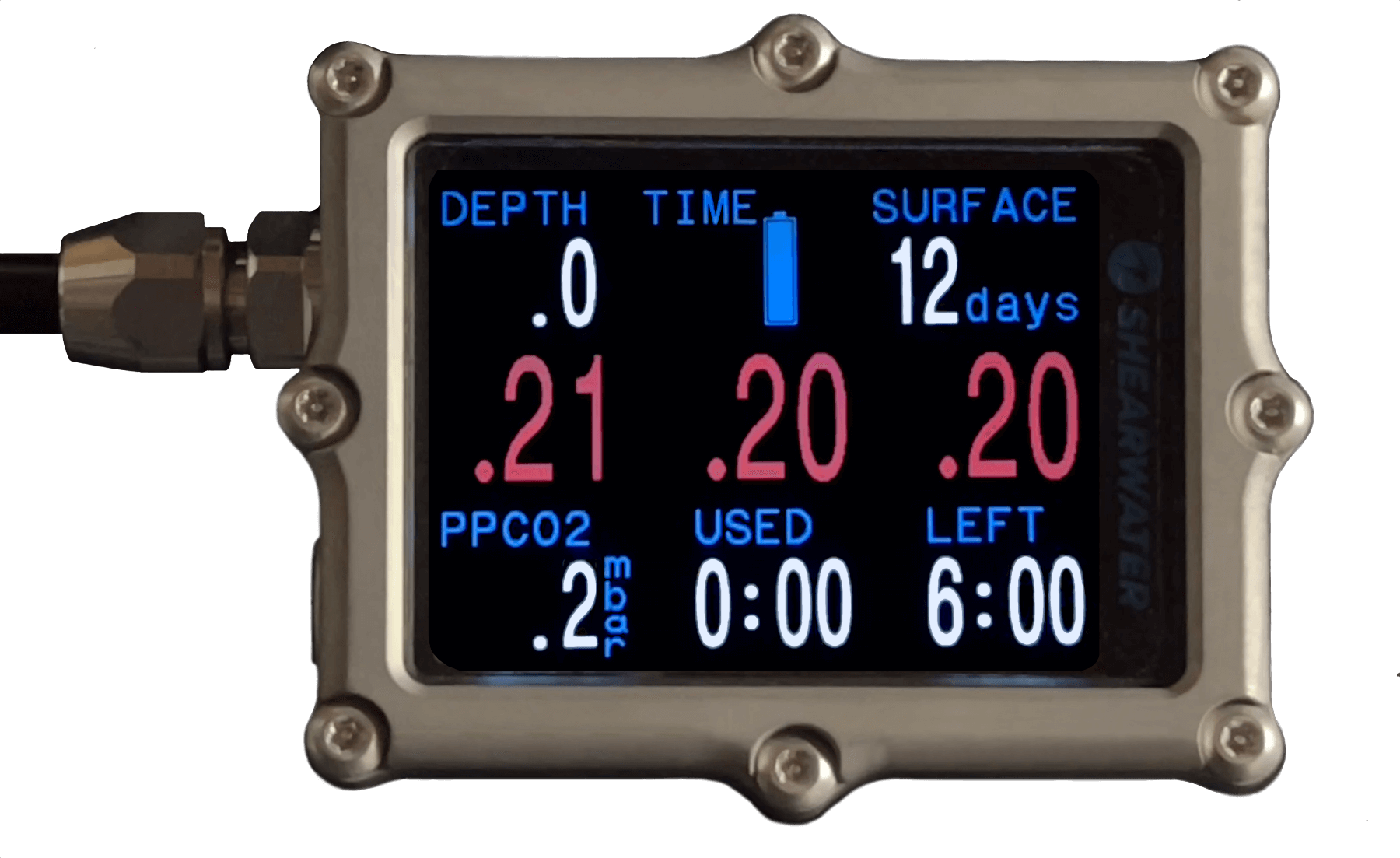X-Head & electronics
The X-head is the heart of the XCCR, which
contains the control electronics, the
solenoid valve for controlled dosing of
oxygen, two high-pressure sensors, the
removable Cartridge carrying three oxygen
sensors and one CO2 sensor, two
replaceable Li-Ion batteries 18650,
watertight connectors for connection of
external computers as well as hose
connectors with a unique Click-Lock
bayonet for easy and fast connection of the
breathing hoses.
The Control electronics
(Shearwater SOLO board) is built in the
hermetic compartment inside the head.
The SOLO board uses ppO2 readings from
three O2 sensors to autonomously maintain
the ppO2 in the breathing loop in
accordance with the current chosen
setpoint.
Modular design compartmentalizes critical functions for redundancy. The Solenoid and
Oxygen electronics (on the SOLO board) can measure and inject oxygen independently of
the Primary handset even in case that the handset or its cable is unplugged or damaged.,
while the SOLO board continues to control loop PPO2 until the diver is surfacing.
The control electronics uses the DiveCAN®, a digital communication standard developed
by Shearwater Research Inc. specifically for rebreathers for robust error-checked
communications, when a message is either received correctly or it isn’t.
The DiveCAN® is easily upgradable and expandable.
PPO2 reading output from all the three oxygen sensors are electronically separated one
from another as well as the PPO2 reading outputs to the Primary Controller, Head-Up
Display and the secondary computer are electronically separated one from another.
In the event of a failure or short circuit on any sensor or connected device, it does not
affect the remaining ppO2 readings on a working device.
The secondary Monitoring Bus is independent on the Controller Bus and provides backup
PPO2 monitoring in the event of a failure on the Primary Controller. There is as well the
possibility of connecting a third party analog monitoring computer.
The Primary Controller handset, the Head-Up
Display and or an optional Secondary computer
are connected via the watertight connectors
rated up to 300m depth. The connectors allow
flexible connection of the controller and
monitoring devices as well as easy disconnection
of the devices for travel, upgrades and repair.
Three Oxygen sensors and built-in solid-state CO2 sensor are placed in the easily
removable sensor cartridge making it easy to
dry, check or replace the sensors. The sensor
cartridge is connected to the head
electronics via the robust 10-pin connector
with gold plated banana pins.
The cartridge is equipped with the wire
handle to easily pull the cartridge out.
The covering lid is closed and secured by a
bayonet locking ring.
The Solenoid valve has a Stainless steel
AISI 316 body and operates up to 17 bar
(above the ambient pressure), therefore no
low-pressure adjustment on the 1st stage
regulator is needed.
The solenoid is connected to the swivel
fitting with built-in O2-filter.
High pressure sensors 300 bar
are integrated at the top of the
head and provide readings of
high pressure in the on-board gas
cylinders with displaying on the
Primary Controller Handset
display.
Two independent and replaceable
Li-Ion 18650 batteries provide power
supply of the control electronics board.
They are located in two separate
compartments on the sides of the head
and are completely separated from the
breathing loop.
The Battery #1 supplies the Solenoid while
the Battery #2 supplies the Head-Up
Display and ppO2 reading output for an
additional secondary monitoring
computer.
The batteries are easy accessible via the
battery caps on the X-head.
The XCCR head is mounted and safely
locked to the Canister via the industry
unique Quick Bayonet Lock.
To lock the head, just turn the head
bayonet ring clockwise until it stops and
clicks-up, then the head is safely locked on
the canister.
To remove the head from the canister, just
push the head bayonet ring a little bit
down and turn it counterclockwise to
unlock the head and pull it up.
Primary Controller Handset
is the Shearwater DiveCAN Petrel2 Controller, specifically designed for the XCCR.
The Primary Controller Handset is connected to the control electronics in the head via a robust, durable and very flexible cable with the X-connector, made of AISI 316L rated up
to 300m depth and marked with a GREEN ring.
Primary Controller Feature List
– Two PPO2 set-points, which can be set between 0.5 and 1.5
– Automatic PPO2 set-point switching (configurable)
– Depth, time, 3x ppO2 and deco data display
– High pressure readings display
– CO2 reading and Stack Timer display
– Bühlmann decompression model with gradient factors
conservatism – Optional VPM-B decompression model
– 5 CC and 5 OC gases
– Gases can be changed and added during a dive
– CNS tracking
– No lockout from violating deco stops
– Any combination of oxygen, nitrogen, and helium (Air, Nitrox,
Trimix) – Open and closed circuit, switchable during a dive
– Metric and Imperial units
– Automatic turn off on the surface (after 15 minutes)
– Tilt compensated digital compass
– Dive Planner
– 1000 hour dive log memory
– Log downloads and firmware upgrades using Bluetooth
– Flexible user replaceable “AA” battery of almost types
Head-Up Display
The Head-Up Display (HUD) is the compact Shearwater DiveCAN HUD with PPO2
monitoring on three O2 sensors.
The main feature of the Head-Up Display (the HUD) is to show the current status of ppO2
in the breathing loop as well as ppO2 alarms to the diver.
The HUD is connected to the control electronics in the head via a robust, durable and very
flexible cable with the X-connector, made of AISI 316L rated up to 300m depth and
marked with a BLUE ring.
The HUD has wet contacts for automatic turning on when entering water.
The HUD is power supplied by THE battery #2 in the X-head.
The HUD is placed in a two way adjustable holder located on the BOV Shrimp.
NERD 2
is the compact near to eye Shearwater DiveCAN Computer with PPO2 monitoring on
three O2 sensors., which can be optionally used with XCCR instead of the HUD.
he NERD is connected to the head control electronics via a robust, durable and very
flexible cable with the X-connector, made of AISI 316L rated up to 300m depth and
marked with a BLUE ring.
The NERD 2 has wet contacts for automatic turning on when entering water.
The NERD 2 is power supplied by its own Integrated rechargeable battery for up to 15 h
operation time.
The NERD 2 is placed in a three way adjustable holder located at the BOV Shrimp.
NERD 2 Feature Lis
– Depth, time, 3x ppO2 and deco data display
– Bühlmann decompression model with gradient factors conservatism
– Optional VPM-B decompression model
– 5 CC and 5 OC gases
– Gases can be changed and added during a dive – CNS tracking
– No lockout from violating deco stops – Any combination of oxygen, nitrogen, and helium (Air, Nitrox,
Trimix) – Open and closed circuit, switchable during a dive
– Metric and Imperial units – Automatic turn off on the surface (after 15 minutes)
– Tilt compensated digital compass
– Dive Planner – 1000 hour dive log memory
– Log downloads and firmware upgrades using Bluetooth.
Secondary Monitor Feature List
– Depth, time, 3x ppO2 and deco data display
– Bühlmann decompression model with gradient factors conservatism
– Optional VPM-B decompression model
– 5 CC and 5 OC gases
– Gases can be changed and added during a dive
– CNS tracking
– No lockout from violating deco stops
– Any combination of oxygen, nitrogen, and helium (Air, Nitrox,
Trimix) – Open and closed circuit, switchable during a dive
– Metric and Imperial units
– Automatic turn off on the surface (after 15 minutes)
– Tilt compensated digital compass
– Dive Planner
– 1000 hour dive log memory
– Log downloads and firmware upgrades using Bluetooth
Learn more about XCCR:


